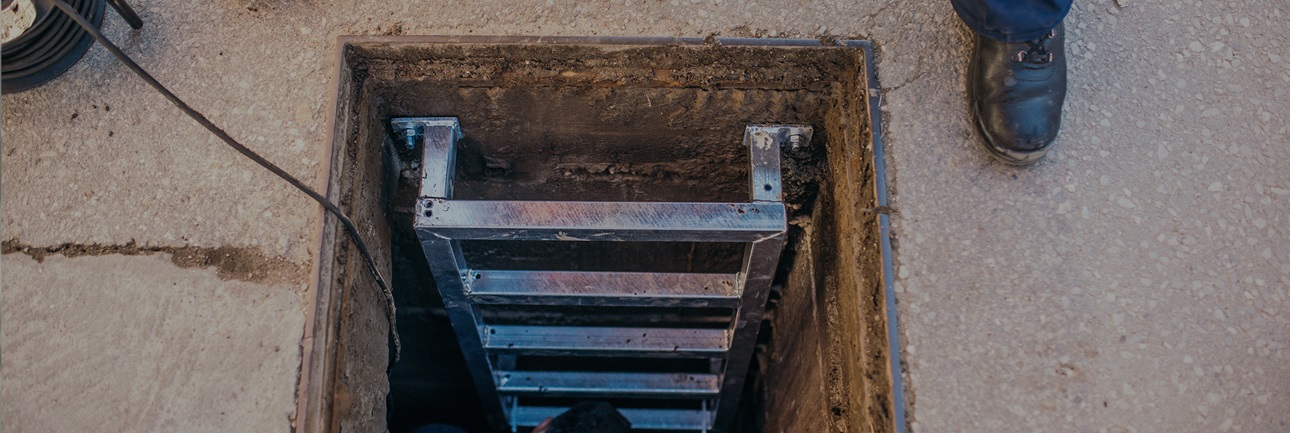Confined spaces, such as manholes, tanks, or sewers are work areas that are not designed for continuous occupancy and may be difficult to exit in the event of an emergency. On May 4, 2015, the Occupational Health & Safety Administration (OSHA) issued a final rule to increase protection for construction workers in confined spaces.
What is a confined space?
As defined by OSHA, a confined space:
- has limited means of entry and/or exit.
- is large enough for a worker to enter it.
- is not intended for regular/continuous occupancy.
What are examples of locations where confined spaces may occur during home construction?
Examples of locations in home building where confined spaces may include, but are not limited to: manholes, sewer systems, stormwater drains, water mains, crawl spaces, attics, heating, ventilation, and air-conditioning (HVAC) ducts and pits.
What is a permit required confined space?
A permit required confined space is a space that may have a hazardous atmosphere, engulfment hazard, or other serious hazard, such as exposed wiring, that can interfere with a worker’s ability to leave the space without assistance. Only workers assigned and trained to work in a permit required confined space may do so. A permit specifying safety measures and names of those permitted in the space must be written before any work can take place. Employers are also required to develop a written confined space program if workers will enter permit required confined spaces.
NAHB-OSHA Confined Spaces Rule Settlement
NAHB reached a settlement with OSHA resolving the association’s legal challenge to the agency’s Confined Spaces in Construction final rule. NAHB filed a Petition for Review of the rule in the U.S. Court of Appeals for the Fifth Circuit.
The settlement, reached after months of negotiations, clarifies that the rule has a very limited application in the residential homebuilding industry. OSHA has published a lengthy Q&A that describes application of the rule to common spaces in the residential homebuilding environment, such as attics, basements, and crawl spaces. The entire Q&A is published here: osha.gov/confinedspaces/.
How does the confined spaces rule apply to residential construction?
The Q&A clarifies that the vast majority of the rule’s requirements only apply to permit-required confined spaces. Attics, basements and crawl spaces in a residential home will not typically trigger these requirements.
The Q&A also clarifies that the mere presence of physical hazards (such as electrical equipment and mechanical hazards) in a space in a residential home would not make the space a permit-required confined space under the rule. The presence of physical hazards would only make a space a permit-required confined space if an entrant has exposure to a serious hazard and the exposure could impede the entrant’s ability to exit the space without assistance.
OSHA, in consultation with NAHB, developed a fact sheet on “Confined Spaces in Residential Construction.”
How does the new final rule differ from the rules that previously applied to construction work performed in confined spaces?
The rule requires employers to determine what kinds of confined spaces their workers are in, what hazards could be there, how those hazards should be made safe, what training workers should receive, and how to rescue those workers if anything goes wrong.
If I am a general contractor and hire a subcontractor to do work in a confined space, do I have any responsibilities?
Yes, home builders, or controlling contractors as OSHA labels them, must discuss permit required confined spaces on the site and their hazards with employers who must enter permit required spaces (entry employers), as well as each other before and after entering the space.
The rule makes the controlling contractor the primary point of contact for information about permit spaces at the work site. The controlling contractor, passes information it has about permit confined spaces at the work site on to the employers whose employees will enter the spaces (entry employers).
Likewise, entry employers must give the controlling contractor information about their entry program and hazards they encounter in the space, and the controlling contractor passes that information on to other entry employers. The controlling contractor is also responsible for making sure employers outside a space know not to create hazards in the space, and that entry employers working in a space at the same time do not create hazards for one another’s workers.
Additional Resources
- OSHA Confined Spaces in Construction Q&A
- NAHB Overview of the Confined Spaces in Construction Final Rule (PDF)
- OSHA's Confined Spaces in Construction Overview
(PDF) - Small Entity Compliance Guide (PDF)
- OSHA’s Confined Spaces in Construction Website
- OSHA’s Examples of Permit-Required Confined Space Programs
- OSHA’s Sample Permit and Confined Space Pre-Entry Checklist




